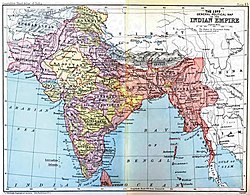Bombay presidency
| Bombay Presidency मुंबई इलाखा (Marathi) મુંબઇ પ્રાંત (Gujarati) ಬಾಂಬೆ ಪ್ರಾಂತ(Kannada) بومبي صدارت(Sindhi) |
|||||
| Presidency of British India | |||||
|
|||||
|
Flag |
|||||
| The Bombay Presidency in 1909, northern portion | |||||
| Historical era | New Imperialism | ||||
| • | Establishment of the Western Presidency at Surat | 1618 | |||
| • | Bombay Presidency Split into Sindh and Bombay state | 1947 | |||
| • | Indian independence | 1947 | |||

Imperial entities of India
|
|
| Dutch India | 1605–1825 |
|---|---|
| Danish India | 1620–1869 |
| French India | 1769–1954 |
|
|
|
| Casa da Índia | 1434–1833 |
| Portuguese East India Company | 1628–1633 |
|
|
|
| East India Company | 1612–1757 |
| Company rule in India | 1757–1858 |
| British Raj | 1858–1947 |
| British rule in Burma | 1824–1948 |
| Princely states | 1721–1949 |
| Partition of India |
1947
|
|
|
|
Flag
The Bombay Presidency, also known as Bombay and Sind from 1843 to 1936 and the Bombay Province, was an administrative subdivision (presidency) of British India. Headquartered in the city of Bombay, at its greatest extent, the presidency included the Konkan, Nashik and Pune divisions of the present-day Indian state of Maharashtra, Ahmadabad, Anand, Bharuch, Gandhinagar, Kheda, Panchmahal and Surat districts of the present-day state of Gujarat, Bagalkot, Belagavi, Bijapur, Dharwad, Gadag, Haveri and Uttara Kannada districts of the present-day state of Karnataka, the Sindh province of present-day Pakistan and the Aden colony, which presently forms part of Yemen.
...
Wikipedia


